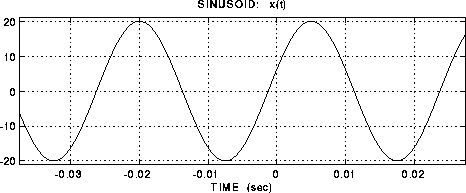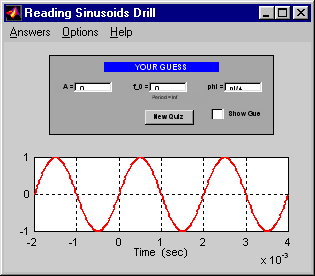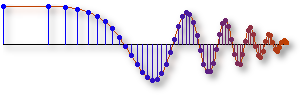
2. Sinusoids

Overview: In chapter two, the most basic waveform in
signal processing, the cosine wave, is presented. The
mathematical formula for the cosine wave, in its most general form
is given below:
x(t)=A cos(2πf0t+φ)
Where x(t) is a function of the time variable t. The amplitude of the cosine is given by the real number A. The frequency of the of the cosine wave is f0, and in the audio experiments that follow, it is the frequency that determines what we hear. Finally, the phase of the sinusoid is given by the parameter φ. A plot of a cosine is given in the figure below:

x(t)=A ej(2πf0t+φ)
The generalization to complex exponentials is important for later work in Fourier analysis, so we are laying a foundation for the future. The real part of the complex exponential is a cosine, and its imaginary part is the sine function, so a plot of the complex exponential is a rotating vector with a constant length A. This signal is called a rotating phasor.
Homework
Labs - MATLAB
| Lab 01: Introduction to Matlab |
 In this lab we introduce the fundamentals of Matlab. Matlab is
a programming environment that you will find helpful for many of
the exercises in this text.
In this lab we introduce the fundamentals of Matlab. Matlab is
a programming environment that you will find helpful for many of
the exercises in this text.
|
| Lab 02a: Introduction to Complex Exponentials - Multipath | Manipulating sinusoid functions using complex exponentials turns trigonometric problems into simple arithmetic and algebra. In this lab, we first review the complex exponential signal and the phasor addition property needed for adding cosine waves. Then we will use Matlab to make plots of phasor diagrams that show the vector addition needed when combining sinusoids. [Files] |
| Lab 02b: Introduction to Complex Exponentials - Direction Finding |
 Manipulating sinusoid functions using complex exponentials turns
trigonometric problems into simple arithmetic and algebra.
In this lab, we first review the complex exponential signal and the
phasor addition property needed for adding cosine waves.
Then we will use Matlab to make plots of phasor diagrams that show
the vector addition needed when combining sinusoids.
[Files]
Manipulating sinusoid functions using complex exponentials turns
trigonometric problems into simple arithmetic and algebra.
In this lab, we first review the complex exponential signal and the
phasor addition property needed for adding cosine waves.
Then we will use Matlab to make plots of phasor diagrams that show
the vector addition needed when combining sinusoids.
[Files]
|
Demos
 |
Rotating Phasor |
 p21 - Shows how the real part of the rotating phasors traces out a sinusoid versus time.
p21 - Shows how the real part of the rotating phasors traces out a sinusoid versus time.
|
 |
Sine Drill |
 p12 - Tests the users ability to determine
basic parameters of a sinusoid.
p12 - Tests the users ability to determine
basic parameters of a sinusoid.
|
 |
ZDrill |
 p26 - Tests users ability to calculate the result
of simple operations on complex numbers.
The program emphasizes the vectorial view of a complex number.
The following six operations are supported:
p26 - Tests users ability to calculate the result
of simple operations on complex numbers.
The program emphasizes the vectorial view of a complex number.
The following six operations are supported:
|
